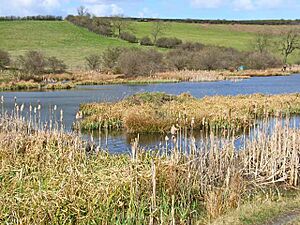National nature reserves in England facts for kids
National nature reserves (NNRs) in England are special places that protect England's amazing wildlife and natural features. Think of them as super important homes for plants and animals! These reserves were created to keep safe the most important areas where different creatures live (called their habitat) and cool natural rock formations (called geological formations).
NNRs are looked after for everyone in England. Many are managed by an organization called Natural England. But other groups also help, like The Wildlife Trusts, the National Trust, and the Royal Society for the Protection of Birds. These groups work hard to make sure these places stay healthy and safe for nature.
There are 221 NNRs across England, covering about 1,100 square kilometers. That's a lot of protected land! Often, you can find rare or very important groups of species in these reserves. This includes special birds, unique plants, interesting insects, reptiles, and mammals that might not be found easily anywhere else.
Contents
Why National Nature Reserves Are Important
National nature reserves are super important for many reasons. They help protect different kinds of ecosystems, from forests and wetlands to sand dunes and grasslands. By keeping these areas safe, we make sure that many different types of plants and animals have a place to live and thrive.
Protecting Rare Species
One of the main jobs of NNRs is to protect species that are rare or endangered. This means plants and animals that are not found in many places, or whose numbers are getting very low. The reserves provide a safe home where these species can grow and reproduce without being disturbed. For example, some NNRs protect special butterflies, rare wildflowers, or unique birds that need very specific conditions to survive.
Studying Nature
NNRs are also great places for scientists and students to learn about nature. They can study how different plants and animals live together, how ecosystems work, and how to best protect them. This research helps us understand more about our natural world and how we can keep it healthy for the future.
Enjoying the Outdoors
Many NNRs are open to the public, allowing people to visit and enjoy nature. You can often find walking trails, bird-watching spots, and educational centers. Visiting an NNR is a fantastic way to connect with nature, see amazing wildlife, and learn about the environment. It's important to remember to follow the rules and respect the wildlife when you visit.
Spotlight NNRs: Special Places to See
Natural England has chosen 35 of these reserves as "spotlight reserves." These are some of the most amazing and important NNRs in England, showcasing a wide variety of habitats and wildlife. Here are a few examples of these special places:
- Ainsdale Sand Dunes NNR, Merseyside
- Aston Rowant NNR, Oxfordshire
- Barnack Hills & Holes NNR, Cambridgeshire
- Castle Eden Dene, County Durham
- Derbyshire Dales NNR, Derbyshire
- Duncombe Park NNR, North Yorkshire
- Durham Coast, County Durham
- East Dartmoor Woods and Heaths NNR, Devon
- Farne Islands NNR, Northumberland
- Fenn's, Whixall and Bettisfield Mosses NNR, Shropshire/Wales
- Finglandrigg Woods NNR, Cumbria
- Gait Barrows NNR, Lancashire
- Gibraltar Point NNR, Lincolnshire
- Golitha Falls NNR, Cornwall
- Holkham NNR, Norfolk
- Ingleborough NNR, North Yorkshire
- Kingley Vale NNR, West Sussex
- Lindisfarne, Northumberland
- Lower Derwent Valley NNR, East Riding of Yorkshire
- Moor House-Upper Teesdale, Cumbria & County Durham
- North Meadow, Cricklade NNR, Wiltshire
- Old Winchester Hill NNR, Hampshire
- Redgrave and Lopham Fen, Norfolk & Suffolk
- Saltfleetby-Theddlethorpe Dunes NNR, Lincolnshire
- Shapwick Heath NNR, Somerset
- Slapton Ley NNR, Devon
- Stiperstones NNR, Shropshire
- Stodmarsh NNR, Kent
- Studland and Godlingston Heath NNR, Dorset
- Teesmouth NNR, Teesside
- The Lizard NNR, Cornwall
- Suffolk Coast NNR, Suffolk
- Thursley NNR, Surrey
- Wicken Fen, Cambridgeshire
- Wye NNR, Kent
If you want to see a complete list of all the NNRs in England, you can check out List of national nature reserves in England.


